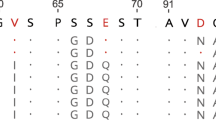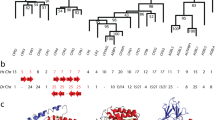Abstract
Although the complete genome sequences of over 50 representative species have revealed the many duplicated genes in all three domains of life1,2,3,4, the roles of gene duplication in organismal adaptation and biodiversity are poorly understood. In addition, the evolutionary forces behind the functional divergence of duplicated genes are often unknown, leading to disagreement on the relative importance of positive Darwinian selection versus relaxation of functional constraints in this process5,6,7,8,9,10. The methodology of earlier studies relied largely on DNA sequence analysis but lacked functional assays of duplicated genes, frequently generating contentious results11,12. Here we use both computational and experimental approaches to address these questions in a study of the pancreatic ribonuclease gene (RNASE1) and its duplicate gene (RNASE1B) in a leaf-eating colobine monkey, douc langur. We show that RNASE1B has evolved rapidly under positive selection for enhanced ribonucleolytic activity in an altered microenvironment, a response to increased demands for the enzyme for digesting bacterial RNA. At the same time, the ability to degrade double-stranded RNA, a non-digestive activity characteristic of primate RNASE1, has been lost in RNASE1B, indicating functional specialization and relaxation of purifying selection. Our findings demonstrate the contribution of gene duplication to organismal adaptation and show the power of combining sequence analysis and functional assays in delineating the molecular basis of adaptive evolution.
This is a preview of subscription content, access via your institution
Access options
Subscribe to this journal
Receive 12 print issues and online access
$209.00 per year
only $17.42 per issue
Buy this article
- Purchase on Springer Link
- Instant access to full article PDF
Prices may be subject to local taxes which are calculated during checkout




Similar content being viewed by others
Accession codes
References
Tomb, J.F. et al. The complete genome sequence of the gastric pathogen Helicobacter pylori. Nature 388, 539–547 (1997).
Makarova, K.S. et al. Comparative genomics of the Archaea (Euryarchaeota): evolution of conserved protein families, the stable core, and the variable shell. Genome Res. 9, 608–628 (1999).
Rubin, G.M. et al. Comparative genomics of the eukaryotes. Science 287, 2204–2215 (2000).
Gaudieri, S., Kulski, J.K., Dawkins, R.L. & Gojobori, T. Different evolutionary histories in two subgenomic regions of the major histocompatibility complex. Genome Res. 9, 541–549 (1999).
Ohno, S. Ancient linkage groups and frozen accidents. Nature 244, 259–262 (1973).
Goodman, M., Moore, G.W. & Matsuda, G. Darwinian evolution in the genealogy of haemoglobin. Nature 253, 603–608 (1975).
Li, W.H. & Gojobori, T. Rapid evolution of goat and sheep globin genes following gene duplication. Mol. Biol. Evol. 1, 94–108 (1983).
Kimura, M. The Neutral Theory of Molecular Evolution. (Cambridge University Press, Cambridge, 1983).
Zhang, J., Rosenberg, H.F. & Nei, M. Positive Darwinian selection after gene duplication in primate ribonuclease genes. Proc. Natl Acad. Sci. USA 95, 3708–3713 (1998).
Hughes, A.L. Adaptive Evolution of Genes and Genomes (Oxford University Press, New York, 1999).
Brookfield, J.F. & Sharp, P.M. Neutralism and selectionism face up to DNA data. Trends Genet. 10, 109–111 (1994).
Charlesworth, B., Charlesworth, D., Nurminsky, D.I. & Hartl, D.L. How was the Sdic gene fixed? Nature 400, 519–520 (1999).
Kay, R.N.B. & Davies, A.G. in Colobinem Monkeys: Their Ecology, Behaviour and Evolution (eds Davies, A.G. & Oates, J.F.) 229–250 (Cambridge University Press, Cambridge, 1994).
Barnard, E.A. Biological function of pancreatic ribonuclease. Nature 221, 340–344 (1969).
Beintema, J.J. The primary structure of langur (Presbytis entellus) pancreatic ribonuclease: adaptive features in digestive enzymes in mammals. Mol. Biol. Evol. 7, 470–477 (1990).
Goodman, M. et al. Toward a phylogenetic classification of primates based on DNA evidence complemented by fossil evidence. Mol. Phylogenet. Evol. 9, 585–598 (1998).
Fitch, W.M. Toward defining the course of evolution: minimum change for a specific tree topology. Syst. Zool. 20, 406–416 (1971).
Zhang, J. & Nei, M. Accuracies of ancestral amino acid sequences inferred by parsimony, likelihood, and distance methods. J. Mol. Evol. 44, S139–S146 (1997).
Tajima, F. Simple methods for testing the molecular evolutionary clock hypothesis. Genetics 135, 599–607 (1993).
Delsen, E. in Colobine Monkeys: Their Ecology, Behaviour and Evolution (eds Davies, A.G. & Oates, J.F.) 11–44 (Cambridge University Press, Cambridge, 1994).
Li, W.H. Molecular Evolution 221–224 (Sinauer Associates, Sunderland, Massachusetts, 1997).
Zhang, J. Rates of conservative and radical nonsynonymous nucleotide substitutions in mammalian nuclear genes. J. Mol. Evol. 50, 56–68 (2000).
Sorrentino, S. & Libonati, M. Structure-function relationships in human ribonucleases: main distinctive features of the major RNase types. FEBS Lett. 404, 1–5 (1997).
Guyton, A.C. & Hall, J.E. Textbook of Medical Physiology 9th edn (Saunders, London, 1996).
Code, C.F. Handbook of Physiology Vol. III (American Physiological Association, Washington DC, 1968).
Futami, J. et al. Tissue-specific expression of pancreatic-type RNases and RNase inhibitor in humans. DNA Cell Biol. 16, 413–419 (1997).
Hughes, A.L. The evolution of functionally novel proteins after gene duplication. Proc. R. Soc. Lond. B Biol. Sci. 256, 119–124 (1994).
Lynch, M. & Force, A. The probability of duplicate gene preservation by subfunctionalization. Genetics 154, 459–473 (2000).
Kimura, M. A simple method for estimating evolutionary rates of base substitutions through comparative studies of nucleotide sequences. J. Mol. Evol. 16, 111–120 (1980).
Rooney, A.P. & Zhang, J. Rapid evolution of a primate sperm protein: relaxation of functional constraint or positive Darwinian selection? Mol. Biol. Evol. 16, 706–710 (1999).
Zhang, J., Kumar, S. & Nei, M. Small-sample tests of episodic adaptive evolution: a case study of primate lysozyme genes. Mol. Biol. Evol. 14, 1335–1338 (1997).
Rosenberg, H.F. & Dyer, K.D. Eosinophil cationic protein and eosinophil-derived neurotoxin. Evolution of novel function in a primate ribonuclease gene family. J. Biol. Chem. 270, 21539–21544 (1995).
Libonati, M. & Floridi, A. Breakdown of double-stranded RNA by bull semen ribonuclease. Eur. J. Biochem. 8, 81–87 (1969).
Acknowledgements
We thank K. Dyer for technical assistance and J. Beintema, A. Rooney and three anonymous referees for their comments on early versions of the manuscript. This work was supported in part by a start-up fund and a Rackham grant from the University of Michigan (to J.Z.) and grants from the Natural Science Foundation of China and Chinese Academy of Sciences (to Y.P.Z.).
Author information
Authors and Affiliations
Corresponding author
Rights and permissions
About this article
Cite this article
Zhang, J., Zhang, Yp. & Rosenberg, H. Adaptive evolution of a duplicated pancreatic ribonuclease gene in a leaf-eating monkey. Nat Genet 30, 411–415 (2002). https://doi.org/10.1038/ng852
Received:
Accepted:
Published:
Issue Date:
DOI: https://doi.org/10.1038/ng852
This article is cited by
-
Birth-and-death evolution of ribonuclease 9 genes in Cetartiodactyla
Science China Life Sciences (2023)
-
Transcriptome sequencing and metabolome analysis of food habits domestication from live prey fish to artificial diets in mandarin fish (Siniperca chuatsi)
BMC Genomics (2021)
-
Ordinaries
Journal of Bioeconomics (2021)
-
Insights into Dietary Switch in Cetaceans: Evidence from Molecular Evolution of Proteinases and Lipases
Journal of Molecular Evolution (2020)
-
Cluster expansion of apolipoprotein D (ApoD) genes in teleost fishes
BMC Evolutionary Biology (2019)



